Innovative Talent Management Initiatives: A Project Report on Next Plc
VerifiedAdded on 2022/11/25
|21
|4258
|297
Report
AI Summary
This professional research report examines talent management strategies at Next Plc, a British multinational retailer. The project aims to identify the importance of new initiatives and innovative ways of working in achieving a strategic approach to talent management. The report outlines the project plan, including components like cost, communication, time, and quality, along with the Work Breakdown Structure (WBS) and Gantt chart. The research employs both primary and secondary data collection methods, utilizing questionnaires to gather primary data from 30 Next Plc employees. The findings, presented through frequency distribution analysis, reveal insights into the company's initiatives, innovative practices, strategic approaches, and the perceived effectiveness of its talent management efforts. The report concludes with recommendations based on the research findings, offering a comprehensive analysis of talent management within Next Plc.
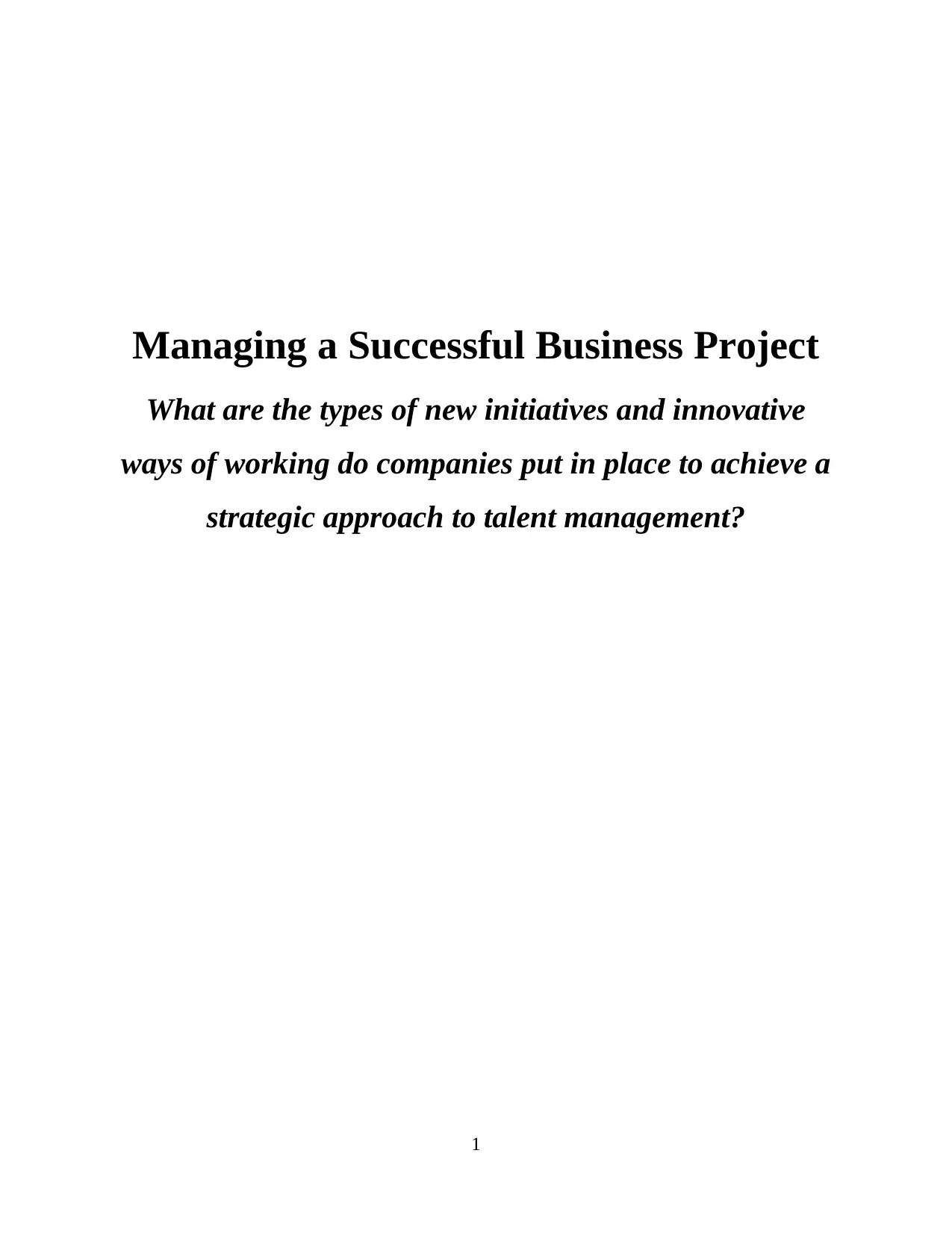
Managing a Successful Business Project
What are the types of new initiatives and innovative
ways of working do companies put in place to achieve a
strategic approach to talent management?
1
What are the types of new initiatives and innovative
ways of working do companies put in place to achieve a
strategic approach to talent management?
1
Paraphrase This Document
Need a fresh take? Get an instant paraphrase of this document with our AI Paraphraser
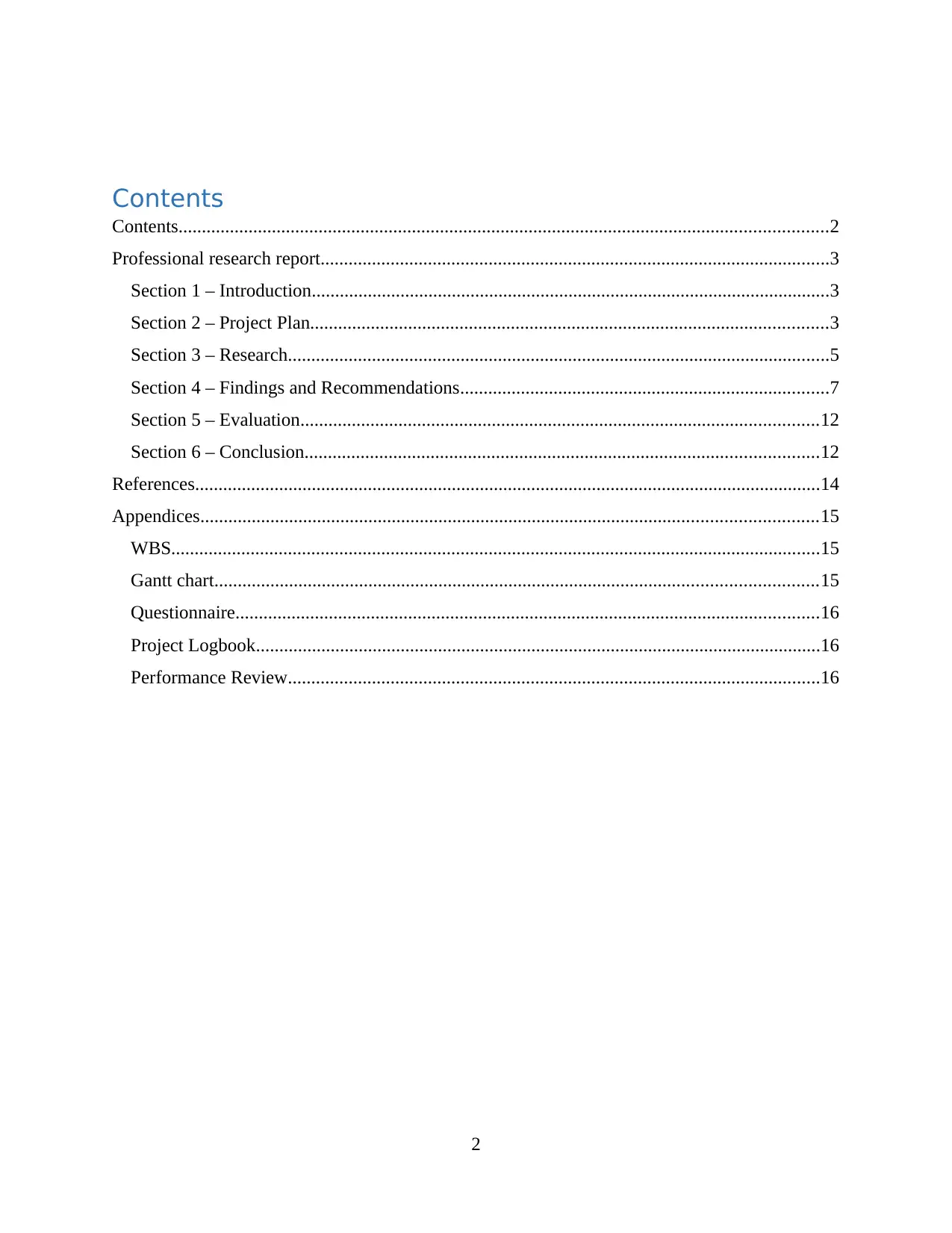
Contents
Contents...........................................................................................................................................2
Professional research report.............................................................................................................3
Section 1 – Introduction...............................................................................................................3
Section 2 – Project Plan...............................................................................................................3
Section 3 – Research....................................................................................................................5
Section 4 – Findings and Recommendations...............................................................................7
Section 5 – Evaluation...............................................................................................................12
Section 6 – Conclusion..............................................................................................................12
References......................................................................................................................................14
Appendices....................................................................................................................................15
WBS...........................................................................................................................................15
Gantt chart.................................................................................................................................15
Questionnaire.............................................................................................................................16
Project Logbook.........................................................................................................................16
Performance Review..................................................................................................................16
2
Contents...........................................................................................................................................2
Professional research report.............................................................................................................3
Section 1 – Introduction...............................................................................................................3
Section 2 – Project Plan...............................................................................................................3
Section 3 – Research....................................................................................................................5
Section 4 – Findings and Recommendations...............................................................................7
Section 5 – Evaluation...............................................................................................................12
Section 6 – Conclusion..............................................................................................................12
References......................................................................................................................................14
Appendices....................................................................................................................................15
WBS...........................................................................................................................................15
Gantt chart.................................................................................................................................15
Questionnaire.............................................................................................................................16
Project Logbook.........................................................................................................................16
Performance Review..................................................................................................................16
2
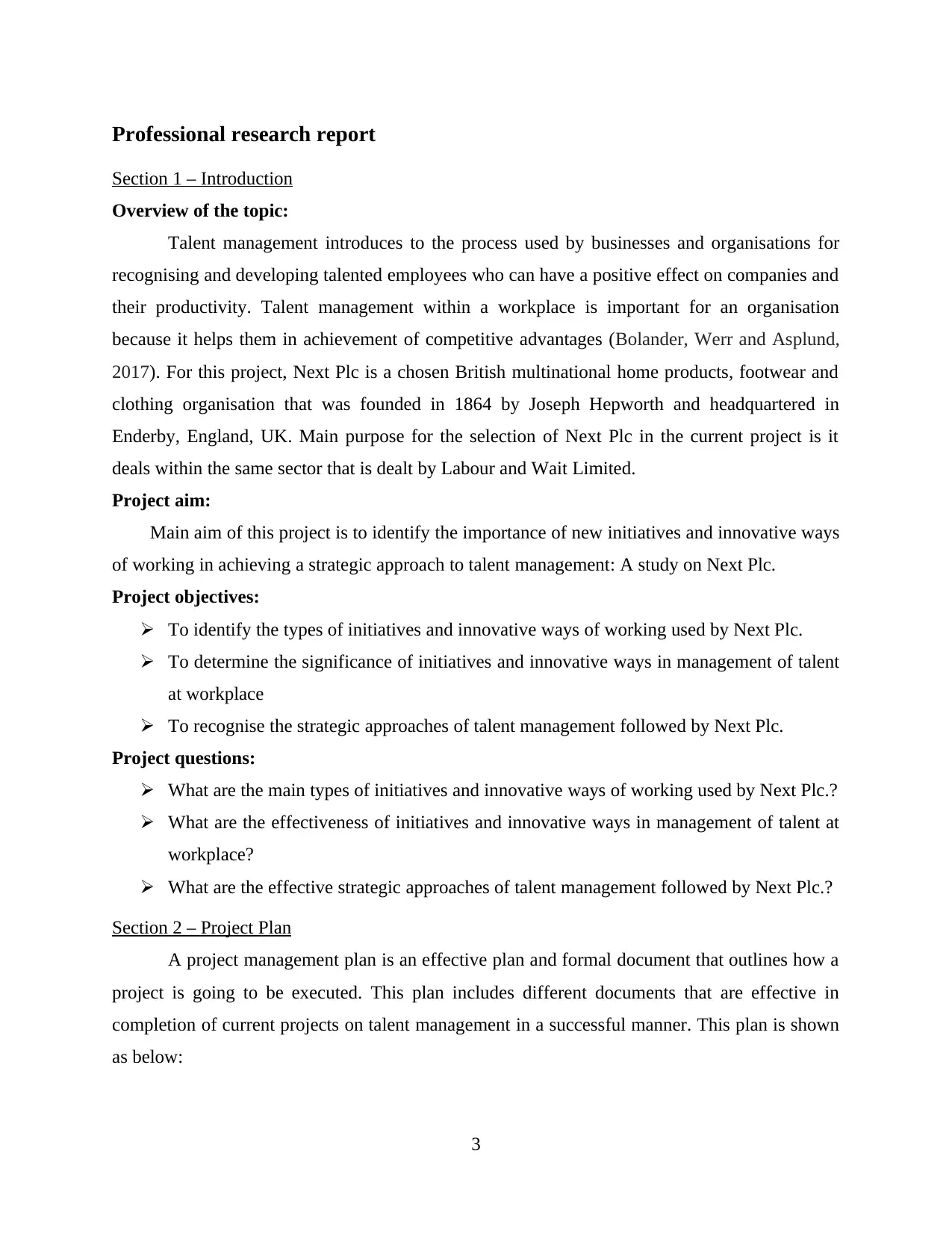
Professional research report
Section 1 – Introduction
Overview of the topic:
Talent management introduces to the process used by businesses and organisations for
recognising and developing talented employees who can have a positive effect on companies and
their productivity. Talent management within a workplace is important for an organisation
because it helps them in achievement of competitive advantages (Bolander, Werr and Asplund,
2017). For this project, Next Plc is a chosen British multinational home products, footwear and
clothing organisation that was founded in 1864 by Joseph Hepworth and headquartered in
Enderby, England, UK. Main purpose for the selection of Next Plc in the current project is it
deals within the same sector that is dealt by Labour and Wait Limited.
Project aim:
Main aim of this project is to identify the importance of new initiatives and innovative ways
of working in achieving a strategic approach to talent management: A study on Next Plc.
Project objectives:
To identify the types of initiatives and innovative ways of working used by Next Plc.
To determine the significance of initiatives and innovative ways in management of talent
at workplace
To recognise the strategic approaches of talent management followed by Next Plc.
Project questions:
What are the main types of initiatives and innovative ways of working used by Next Plc.?
What are the effectiveness of initiatives and innovative ways in management of talent at
workplace?
What are the effective strategic approaches of talent management followed by Next Plc.?
Section 2 – Project Plan
A project management plan is an effective plan and formal document that outlines how a
project is going to be executed. This plan includes different documents that are effective in
completion of current projects on talent management in a successful manner. This plan is shown
as below:
3
Section 1 – Introduction
Overview of the topic:
Talent management introduces to the process used by businesses and organisations for
recognising and developing talented employees who can have a positive effect on companies and
their productivity. Talent management within a workplace is important for an organisation
because it helps them in achievement of competitive advantages (Bolander, Werr and Asplund,
2017). For this project, Next Plc is a chosen British multinational home products, footwear and
clothing organisation that was founded in 1864 by Joseph Hepworth and headquartered in
Enderby, England, UK. Main purpose for the selection of Next Plc in the current project is it
deals within the same sector that is dealt by Labour and Wait Limited.
Project aim:
Main aim of this project is to identify the importance of new initiatives and innovative ways
of working in achieving a strategic approach to talent management: A study on Next Plc.
Project objectives:
To identify the types of initiatives and innovative ways of working used by Next Plc.
To determine the significance of initiatives and innovative ways in management of talent
at workplace
To recognise the strategic approaches of talent management followed by Next Plc.
Project questions:
What are the main types of initiatives and innovative ways of working used by Next Plc.?
What are the effectiveness of initiatives and innovative ways in management of talent at
workplace?
What are the effective strategic approaches of talent management followed by Next Plc.?
Section 2 – Project Plan
A project management plan is an effective plan and formal document that outlines how a
project is going to be executed. This plan includes different documents that are effective in
completion of current projects on talent management in a successful manner. This plan is shown
as below:
3
⊘ This is a preview!⊘
Do you want full access?
Subscribe today to unlock all pages.

Trusted by 1+ million students worldwide
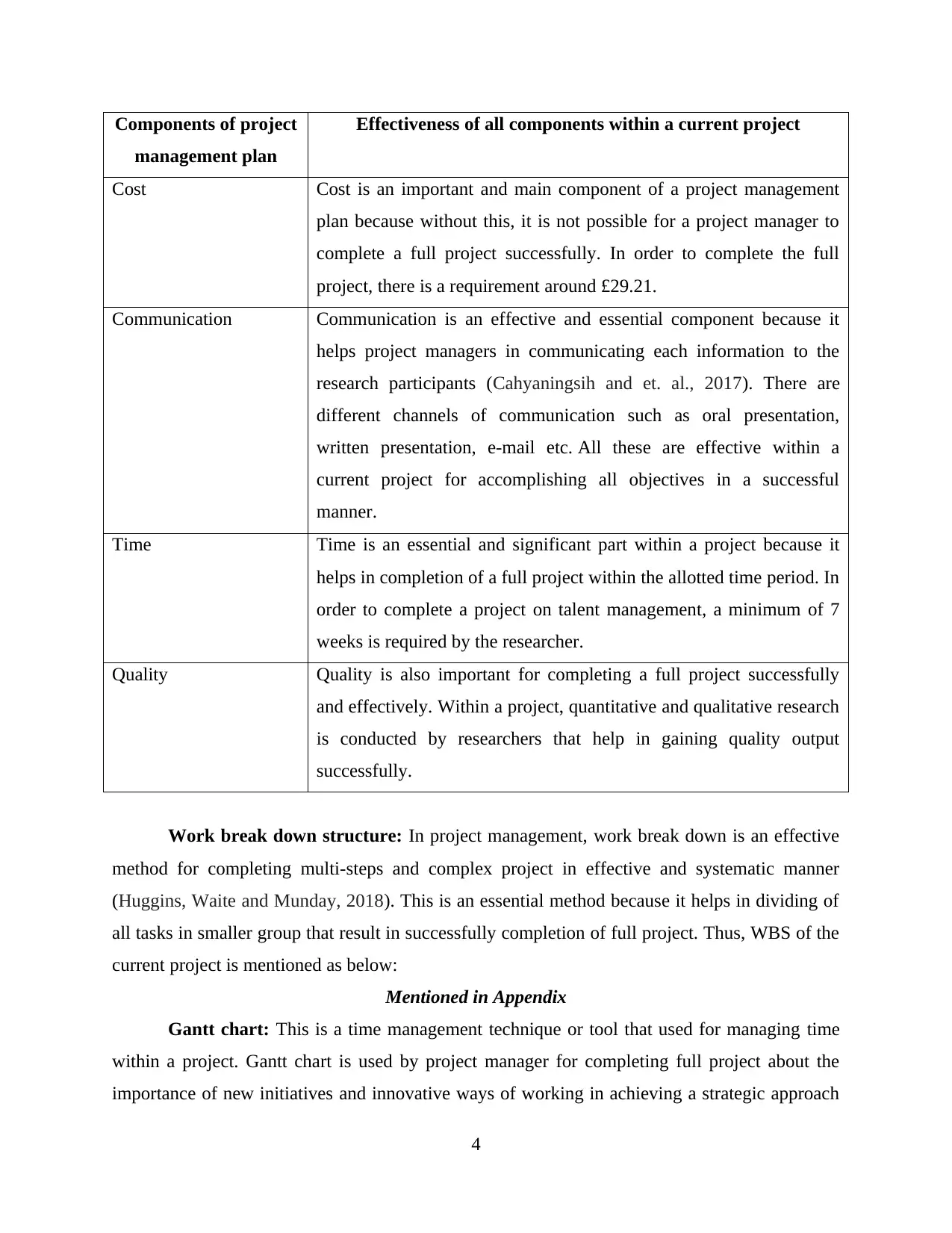
Components of project
management plan
Effectiveness of all components within a current project
Cost Cost is an important and main component of a project management
plan because without this, it is not possible for a project manager to
complete a full project successfully. In order to complete the full
project, there is a requirement around £29.21.
Communication Communication is an effective and essential component because it
helps project managers in communicating each information to the
research participants (Cahyaningsih and et. al., 2017). There are
different channels of communication such as oral presentation,
written presentation, e-mail etc. All these are effective within a
current project for accomplishing all objectives in a successful
manner.
Time Time is an essential and significant part within a project because it
helps in completion of a full project within the allotted time period. In
order to complete a project on talent management, a minimum of 7
weeks is required by the researcher.
Quality Quality is also important for completing a full project successfully
and effectively. Within a project, quantitative and qualitative research
is conducted by researchers that help in gaining quality output
successfully.
Work break down structure: In project management, work break down is an effective
method for completing multi-steps and complex project in effective and systematic manner
(Huggins, Waite and Munday, 2018). This is an essential method because it helps in dividing of
all tasks in smaller group that result in successfully completion of full project. Thus, WBS of the
current project is mentioned as below:
Mentioned in Appendix
Gantt chart: This is a time management technique or tool that used for managing time
within a project. Gantt chart is used by project manager for completing full project about the
importance of new initiatives and innovative ways of working in achieving a strategic approach
4
management plan
Effectiveness of all components within a current project
Cost Cost is an important and main component of a project management
plan because without this, it is not possible for a project manager to
complete a full project successfully. In order to complete the full
project, there is a requirement around £29.21.
Communication Communication is an effective and essential component because it
helps project managers in communicating each information to the
research participants (Cahyaningsih and et. al., 2017). There are
different channels of communication such as oral presentation,
written presentation, e-mail etc. All these are effective within a
current project for accomplishing all objectives in a successful
manner.
Time Time is an essential and significant part within a project because it
helps in completion of a full project within the allotted time period. In
order to complete a project on talent management, a minimum of 7
weeks is required by the researcher.
Quality Quality is also important for completing a full project successfully
and effectively. Within a project, quantitative and qualitative research
is conducted by researchers that help in gaining quality output
successfully.
Work break down structure: In project management, work break down is an effective
method for completing multi-steps and complex project in effective and systematic manner
(Huggins, Waite and Munday, 2018). This is an essential method because it helps in dividing of
all tasks in smaller group that result in successfully completion of full project. Thus, WBS of the
current project is mentioned as below:
Mentioned in Appendix
Gantt chart: This is a time management technique or tool that used for managing time
within a project. Gantt chart is used by project manager for completing full project about the
importance of new initiatives and innovative ways of working in achieving a strategic approach
4
Paraphrase This Document
Need a fresh take? Get an instant paraphrase of this document with our AI Paraphraser
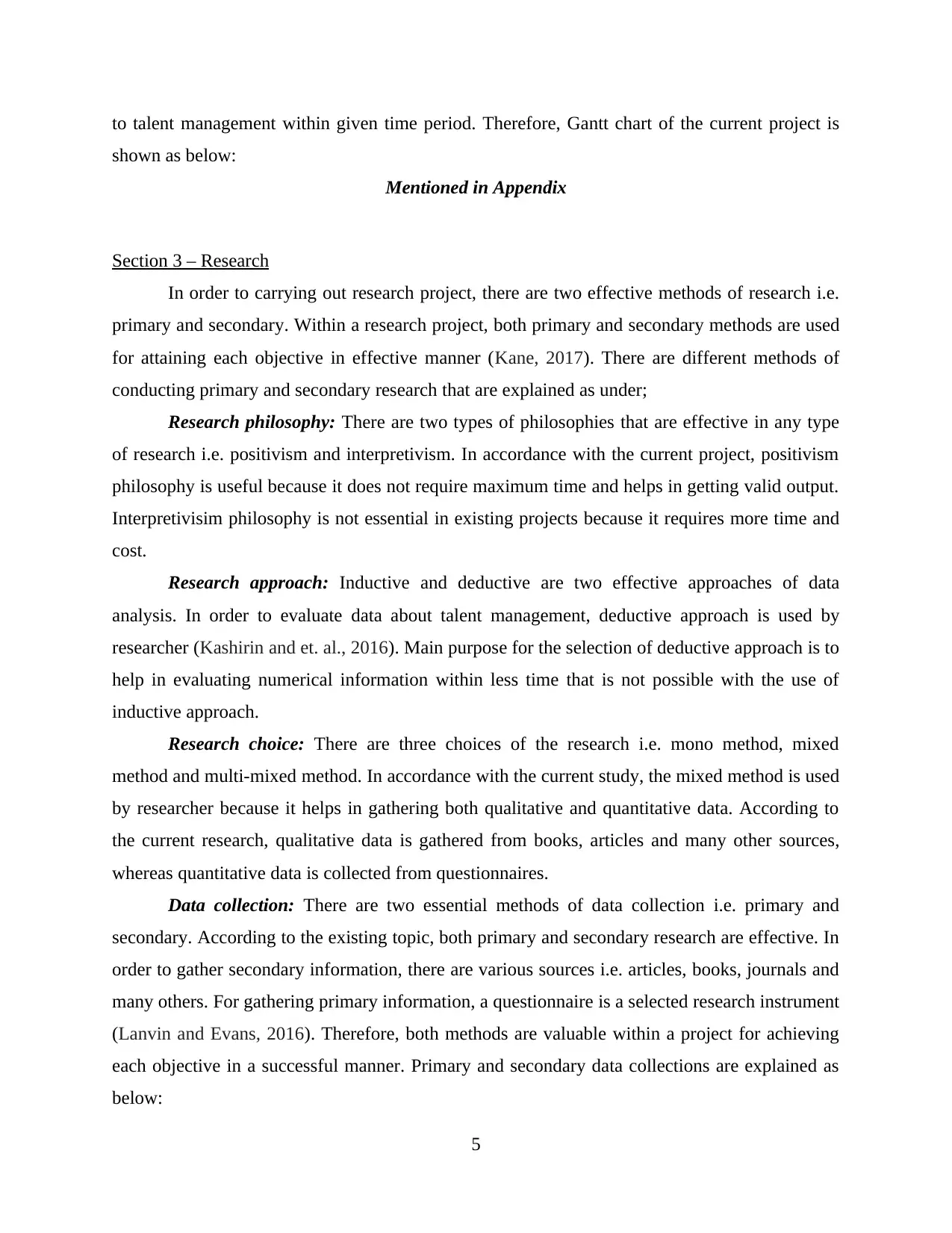
to talent management within given time period. Therefore, Gantt chart of the current project is
shown as below:
Mentioned in Appendix
Section 3 – Research
In order to carrying out research project, there are two effective methods of research i.e.
primary and secondary. Within a research project, both primary and secondary methods are used
for attaining each objective in effective manner (Kane, 2017). There are different methods of
conducting primary and secondary research that are explained as under;
Research philosophy: There are two types of philosophies that are effective in any type
of research i.e. positivism and interpretivism. In accordance with the current project, positivism
philosophy is useful because it does not require maximum time and helps in getting valid output.
Interpretivisim philosophy is not essential in existing projects because it requires more time and
cost.
Research approach: Inductive and deductive are two effective approaches of data
analysis. In order to evaluate data about talent management, deductive approach is used by
researcher (Kashirin and et. al., 2016). Main purpose for the selection of deductive approach is to
help in evaluating numerical information within less time that is not possible with the use of
inductive approach.
Research choice: There are three choices of the research i.e. mono method, mixed
method and multi-mixed method. In accordance with the current study, the mixed method is used
by researcher because it helps in gathering both qualitative and quantitative data. According to
the current research, qualitative data is gathered from books, articles and many other sources,
whereas quantitative data is collected from questionnaires.
Data collection: There are two essential methods of data collection i.e. primary and
secondary. According to the existing topic, both primary and secondary research are effective. In
order to gather secondary information, there are various sources i.e. articles, books, journals and
many others. For gathering primary information, a questionnaire is a selected research instrument
(Lanvin and Evans, 2016). Therefore, both methods are valuable within a project for achieving
each objective in a successful manner. Primary and secondary data collections are explained as
below:
5
shown as below:
Mentioned in Appendix
Section 3 – Research
In order to carrying out research project, there are two effective methods of research i.e.
primary and secondary. Within a research project, both primary and secondary methods are used
for attaining each objective in effective manner (Kane, 2017). There are different methods of
conducting primary and secondary research that are explained as under;
Research philosophy: There are two types of philosophies that are effective in any type
of research i.e. positivism and interpretivism. In accordance with the current project, positivism
philosophy is useful because it does not require maximum time and helps in getting valid output.
Interpretivisim philosophy is not essential in existing projects because it requires more time and
cost.
Research approach: Inductive and deductive are two effective approaches of data
analysis. In order to evaluate data about talent management, deductive approach is used by
researcher (Kashirin and et. al., 2016). Main purpose for the selection of deductive approach is to
help in evaluating numerical information within less time that is not possible with the use of
inductive approach.
Research choice: There are three choices of the research i.e. mono method, mixed
method and multi-mixed method. In accordance with the current study, the mixed method is used
by researcher because it helps in gathering both qualitative and quantitative data. According to
the current research, qualitative data is gathered from books, articles and many other sources,
whereas quantitative data is collected from questionnaires.
Data collection: There are two essential methods of data collection i.e. primary and
secondary. According to the existing topic, both primary and secondary research are effective. In
order to gather secondary information, there are various sources i.e. articles, books, journals and
many others. For gathering primary information, a questionnaire is a selected research instrument
(Lanvin and Evans, 2016). Therefore, both methods are valuable within a project for achieving
each objective in a successful manner. Primary and secondary data collections are explained as
below:
5
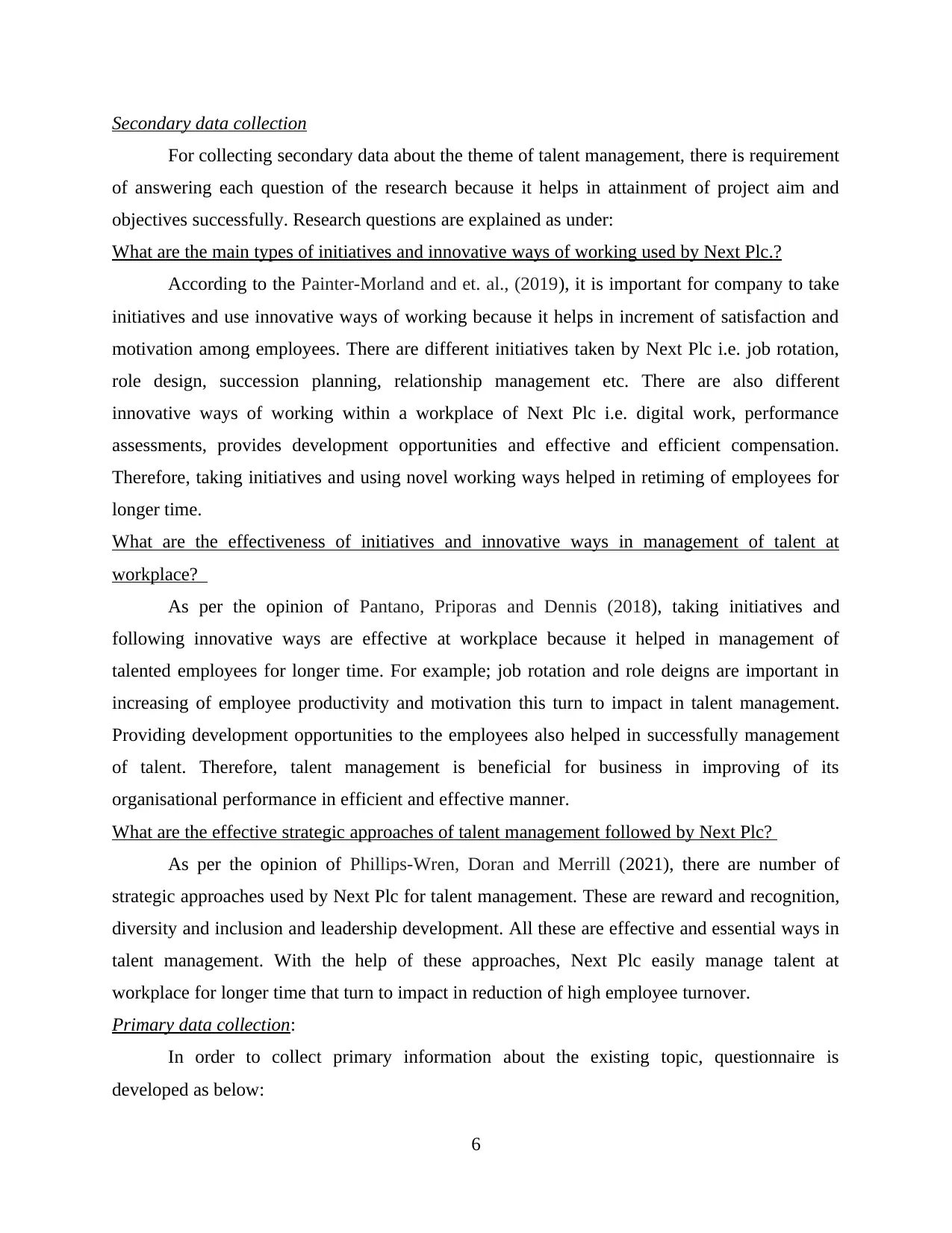
Secondary data collection
For collecting secondary data about the theme of talent management, there is requirement
of answering each question of the research because it helps in attainment of project aim and
objectives successfully. Research questions are explained as under:
What are the main types of initiatives and innovative ways of working used by Next Plc.?
According to the Painter‐Morland and et. al., (2019), it is important for company to take
initiatives and use innovative ways of working because it helps in increment of satisfaction and
motivation among employees. There are different initiatives taken by Next Plc i.e. job rotation,
role design, succession planning, relationship management etc. There are also different
innovative ways of working within a workplace of Next Plc i.e. digital work, performance
assessments, provides development opportunities and effective and efficient compensation.
Therefore, taking initiatives and using novel working ways helped in retiming of employees for
longer time.
What are the effectiveness of initiatives and innovative ways in management of talent at
workplace?
As per the opinion of Pantano, Priporas and Dennis (2018), taking initiatives and
following innovative ways are effective at workplace because it helped in management of
talented employees for longer time. For example; job rotation and role deigns are important in
increasing of employee productivity and motivation this turn to impact in talent management.
Providing development opportunities to the employees also helped in successfully management
of talent. Therefore, talent management is beneficial for business in improving of its
organisational performance in efficient and effective manner.
What are the effective strategic approaches of talent management followed by Next Plc?
As per the opinion of Phillips-Wren, Doran and Merrill (2021), there are number of
strategic approaches used by Next Plc for talent management. These are reward and recognition,
diversity and inclusion and leadership development. All these are effective and essential ways in
talent management. With the help of these approaches, Next Plc easily manage talent at
workplace for longer time that turn to impact in reduction of high employee turnover.
Primary data collection:
In order to collect primary information about the existing topic, questionnaire is
developed as below:
6
For collecting secondary data about the theme of talent management, there is requirement
of answering each question of the research because it helps in attainment of project aim and
objectives successfully. Research questions are explained as under:
What are the main types of initiatives and innovative ways of working used by Next Plc.?
According to the Painter‐Morland and et. al., (2019), it is important for company to take
initiatives and use innovative ways of working because it helps in increment of satisfaction and
motivation among employees. There are different initiatives taken by Next Plc i.e. job rotation,
role design, succession planning, relationship management etc. There are also different
innovative ways of working within a workplace of Next Plc i.e. digital work, performance
assessments, provides development opportunities and effective and efficient compensation.
Therefore, taking initiatives and using novel working ways helped in retiming of employees for
longer time.
What are the effectiveness of initiatives and innovative ways in management of talent at
workplace?
As per the opinion of Pantano, Priporas and Dennis (2018), taking initiatives and
following innovative ways are effective at workplace because it helped in management of
talented employees for longer time. For example; job rotation and role deigns are important in
increasing of employee productivity and motivation this turn to impact in talent management.
Providing development opportunities to the employees also helped in successfully management
of talent. Therefore, talent management is beneficial for business in improving of its
organisational performance in efficient and effective manner.
What are the effective strategic approaches of talent management followed by Next Plc?
As per the opinion of Phillips-Wren, Doran and Merrill (2021), there are number of
strategic approaches used by Next Plc for talent management. These are reward and recognition,
diversity and inclusion and leadership development. All these are effective and essential ways in
talent management. With the help of these approaches, Next Plc easily manage talent at
workplace for longer time that turn to impact in reduction of high employee turnover.
Primary data collection:
In order to collect primary information about the existing topic, questionnaire is
developed as below:
6
⊘ This is a preview!⊘
Do you want full access?
Subscribe today to unlock all pages.

Trusted by 1+ million students worldwide
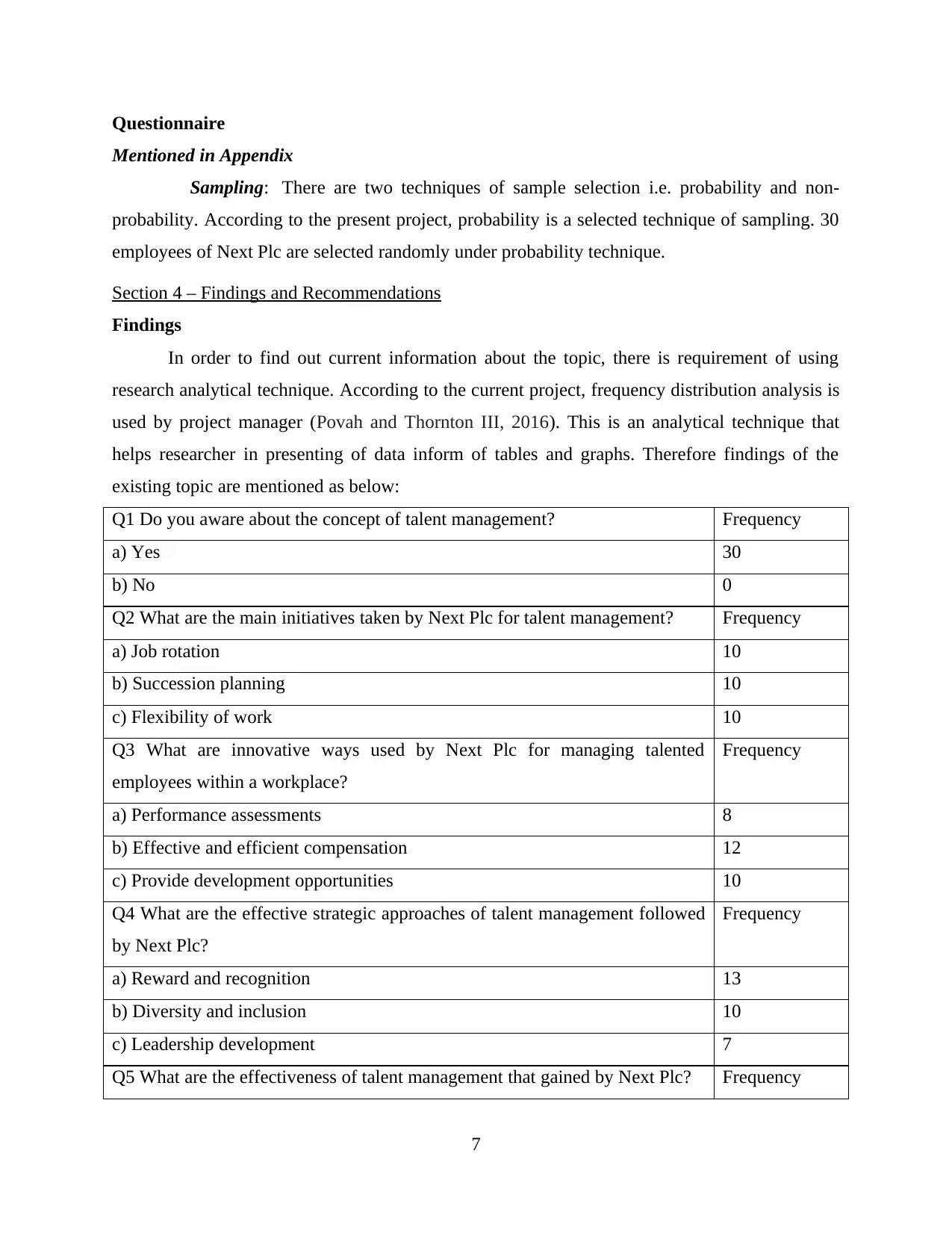
Questionnaire
Mentioned in Appendix
Sampling: There are two techniques of sample selection i.e. probability and non-
probability. According to the present project, probability is a selected technique of sampling. 30
employees of Next Plc are selected randomly under probability technique.
Section 4 – Findings and Recommendations
Findings
In order to find out current information about the topic, there is requirement of using
research analytical technique. According to the current project, frequency distribution analysis is
used by project manager (Povah and Thornton III, 2016). This is an analytical technique that
helps researcher in presenting of data inform of tables and graphs. Therefore findings of the
existing topic are mentioned as below:
Q1 Do you aware about the concept of talent management? Frequency
a) Yes 30
b) No 0
Q2 What are the main initiatives taken by Next Plc for talent management? Frequency
a) Job rotation 10
b) Succession planning 10
c) Flexibility of work 10
Q3 What are innovative ways used by Next Plc for managing talented
employees within a workplace?
Frequency
a) Performance assessments 8
b) Effective and efficient compensation 12
c) Provide development opportunities 10
Q4 What are the effective strategic approaches of talent management followed
by Next Plc?
Frequency
a) Reward and recognition 13
b) Diversity and inclusion 10
c) Leadership development 7
Q5 What are the effectiveness of talent management that gained by Next Plc? Frequency
7
Mentioned in Appendix
Sampling: There are two techniques of sample selection i.e. probability and non-
probability. According to the present project, probability is a selected technique of sampling. 30
employees of Next Plc are selected randomly under probability technique.
Section 4 – Findings and Recommendations
Findings
In order to find out current information about the topic, there is requirement of using
research analytical technique. According to the current project, frequency distribution analysis is
used by project manager (Povah and Thornton III, 2016). This is an analytical technique that
helps researcher in presenting of data inform of tables and graphs. Therefore findings of the
existing topic are mentioned as below:
Q1 Do you aware about the concept of talent management? Frequency
a) Yes 30
b) No 0
Q2 What are the main initiatives taken by Next Plc for talent management? Frequency
a) Job rotation 10
b) Succession planning 10
c) Flexibility of work 10
Q3 What are innovative ways used by Next Plc for managing talented
employees within a workplace?
Frequency
a) Performance assessments 8
b) Effective and efficient compensation 12
c) Provide development opportunities 10
Q4 What are the effective strategic approaches of talent management followed
by Next Plc?
Frequency
a) Reward and recognition 13
b) Diversity and inclusion 10
c) Leadership development 7
Q5 What are the effectiveness of talent management that gained by Next Plc? Frequency
7
Paraphrase This Document
Need a fresh take? Get an instant paraphrase of this document with our AI Paraphraser
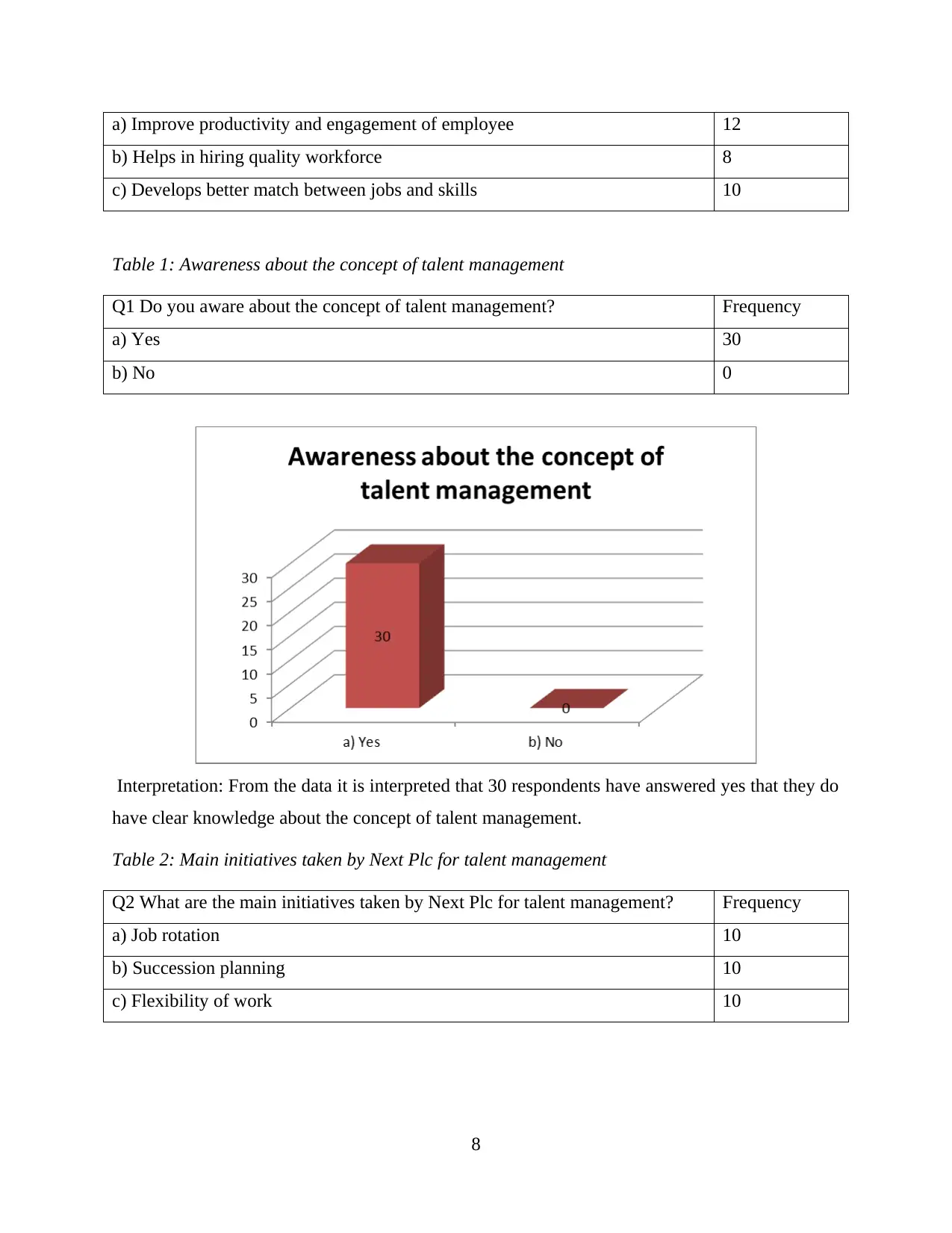
a) Improve productivity and engagement of employee 12
b) Helps in hiring quality workforce 8
c) Develops better match between jobs and skills 10
Table 1: Awareness about the concept of talent management
Q1 Do you aware about the concept of talent management? Frequency
a) Yes 30
b) No 0
Interpretation: From the data it is interpreted that 30 respondents have answered yes that they do
have clear knowledge about the concept of talent management.
Table 2: Main initiatives taken by Next Plc for talent management
Q2 What are the main initiatives taken by Next Plc for talent management? Frequency
a) Job rotation 10
b) Succession planning 10
c) Flexibility of work 10
8
b) Helps in hiring quality workforce 8
c) Develops better match between jobs and skills 10
Table 1: Awareness about the concept of talent management
Q1 Do you aware about the concept of talent management? Frequency
a) Yes 30
b) No 0
Interpretation: From the data it is interpreted that 30 respondents have answered yes that they do
have clear knowledge about the concept of talent management.
Table 2: Main initiatives taken by Next Plc for talent management
Q2 What are the main initiatives taken by Next Plc for talent management? Frequency
a) Job rotation 10
b) Succession planning 10
c) Flexibility of work 10
8
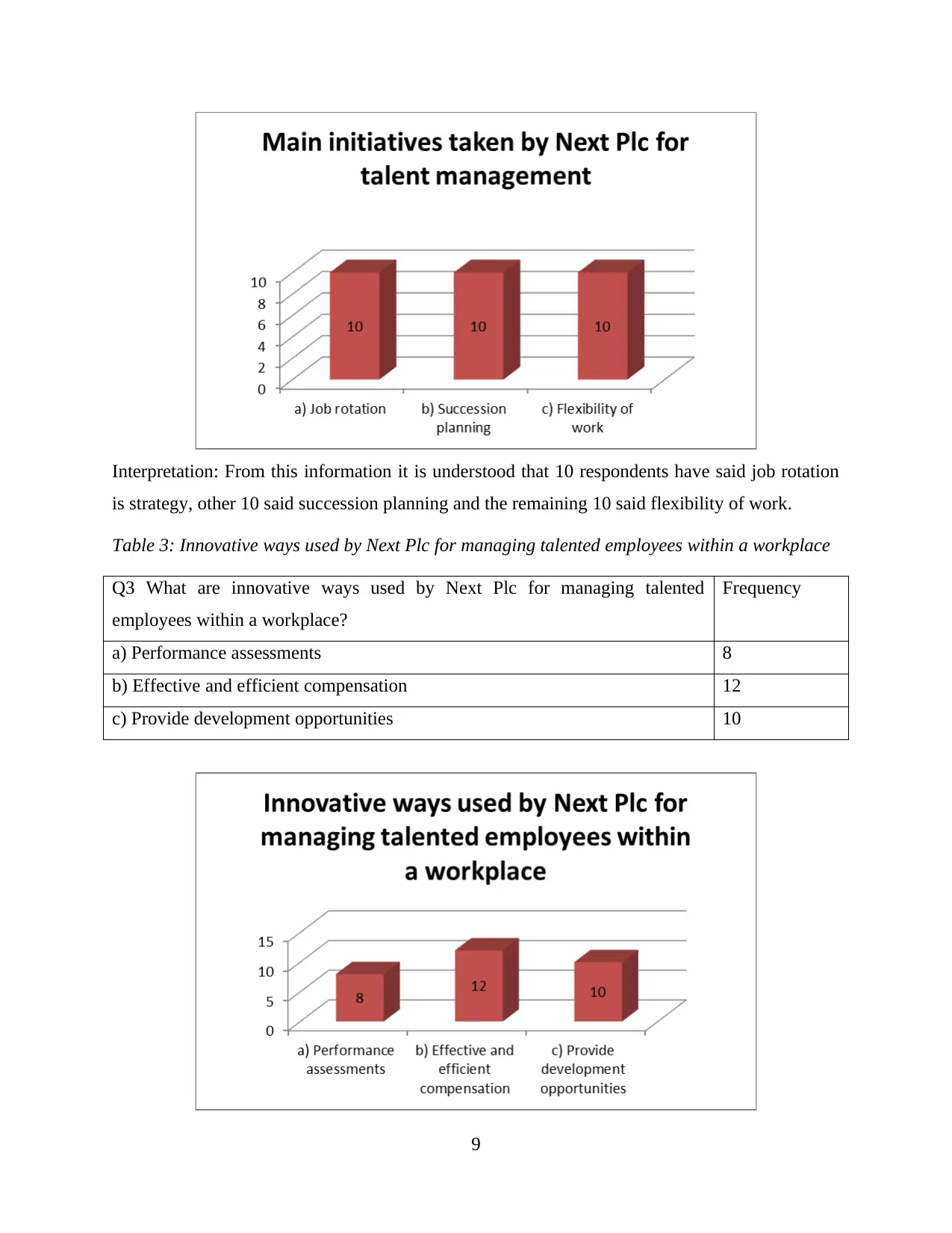
Interpretation: From this information it is understood that 10 respondents have said job rotation
is strategy, other 10 said succession planning and the remaining 10 said flexibility of work.
Table 3: Innovative ways used by Next Plc for managing talented employees within a workplace
Q3 What are innovative ways used by Next Plc for managing talented
employees within a workplace?
Frequency
a) Performance assessments 8
b) Effective and efficient compensation 12
c) Provide development opportunities 10
9
is strategy, other 10 said succession planning and the remaining 10 said flexibility of work.
Table 3: Innovative ways used by Next Plc for managing talented employees within a workplace
Q3 What are innovative ways used by Next Plc for managing talented
employees within a workplace?
Frequency
a) Performance assessments 8
b) Effective and efficient compensation 12
c) Provide development opportunities 10
9
⊘ This is a preview!⊘
Do you want full access?
Subscribe today to unlock all pages.

Trusted by 1+ million students worldwide
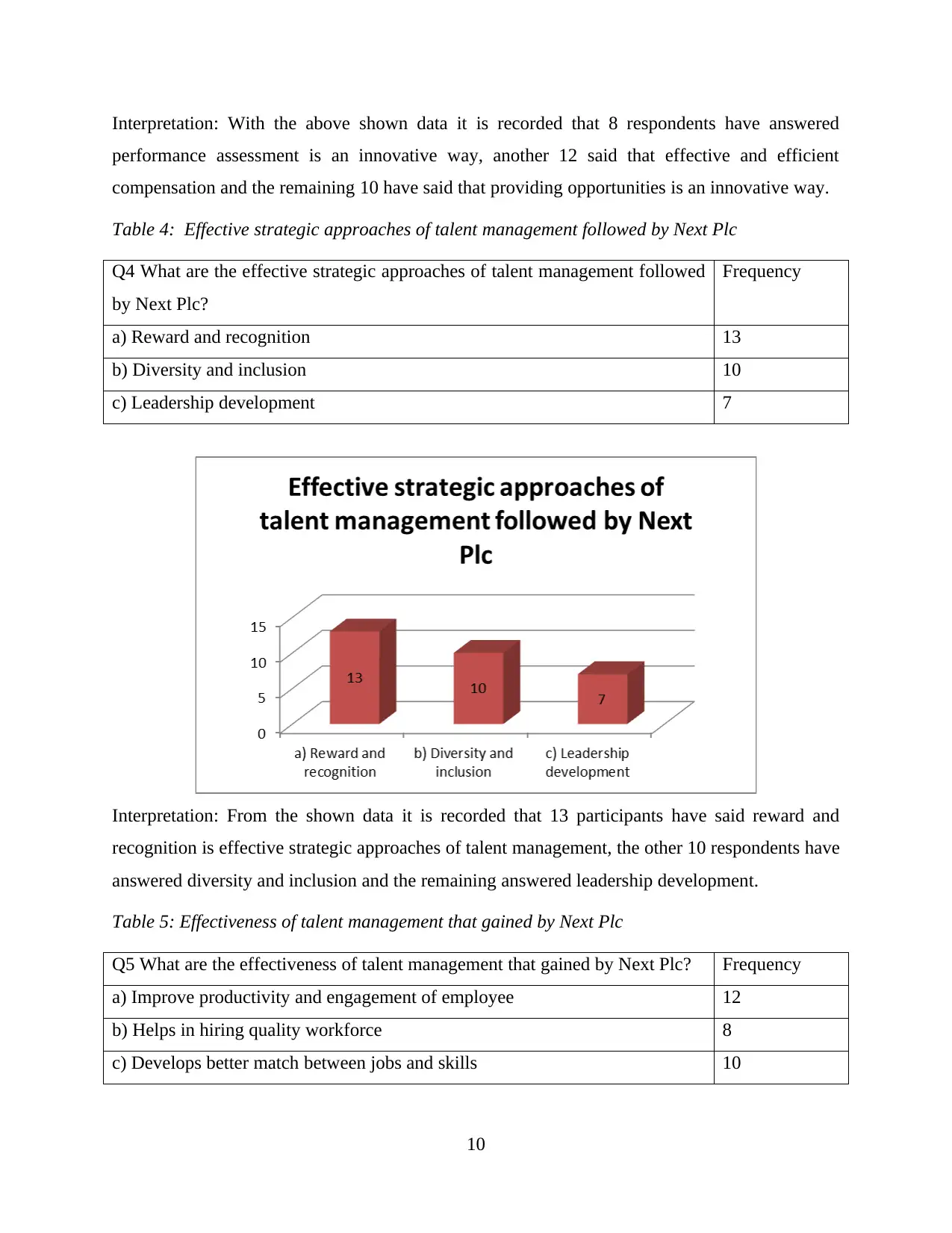
Interpretation: With the above shown data it is recorded that 8 respondents have answered
performance assessment is an innovative way, another 12 said that effective and efficient
compensation and the remaining 10 have said that providing opportunities is an innovative way.
Table 4: Effective strategic approaches of talent management followed by Next Plc
Q4 What are the effective strategic approaches of talent management followed
by Next Plc?
Frequency
a) Reward and recognition 13
b) Diversity and inclusion 10
c) Leadership development 7
Interpretation: From the shown data it is recorded that 13 participants have said reward and
recognition is effective strategic approaches of talent management, the other 10 respondents have
answered diversity and inclusion and the remaining answered leadership development.
Table 5: Effectiveness of talent management that gained by Next Plc
Q5 What are the effectiveness of talent management that gained by Next Plc? Frequency
a) Improve productivity and engagement of employee 12
b) Helps in hiring quality workforce 8
c) Develops better match between jobs and skills 10
10
performance assessment is an innovative way, another 12 said that effective and efficient
compensation and the remaining 10 have said that providing opportunities is an innovative way.
Table 4: Effective strategic approaches of talent management followed by Next Plc
Q4 What are the effective strategic approaches of talent management followed
by Next Plc?
Frequency
a) Reward and recognition 13
b) Diversity and inclusion 10
c) Leadership development 7
Interpretation: From the shown data it is recorded that 13 participants have said reward and
recognition is effective strategic approaches of talent management, the other 10 respondents have
answered diversity and inclusion and the remaining answered leadership development.
Table 5: Effectiveness of talent management that gained by Next Plc
Q5 What are the effectiveness of talent management that gained by Next Plc? Frequency
a) Improve productivity and engagement of employee 12
b) Helps in hiring quality workforce 8
c) Develops better match between jobs and skills 10
10
Paraphrase This Document
Need a fresh take? Get an instant paraphrase of this document with our AI Paraphraser
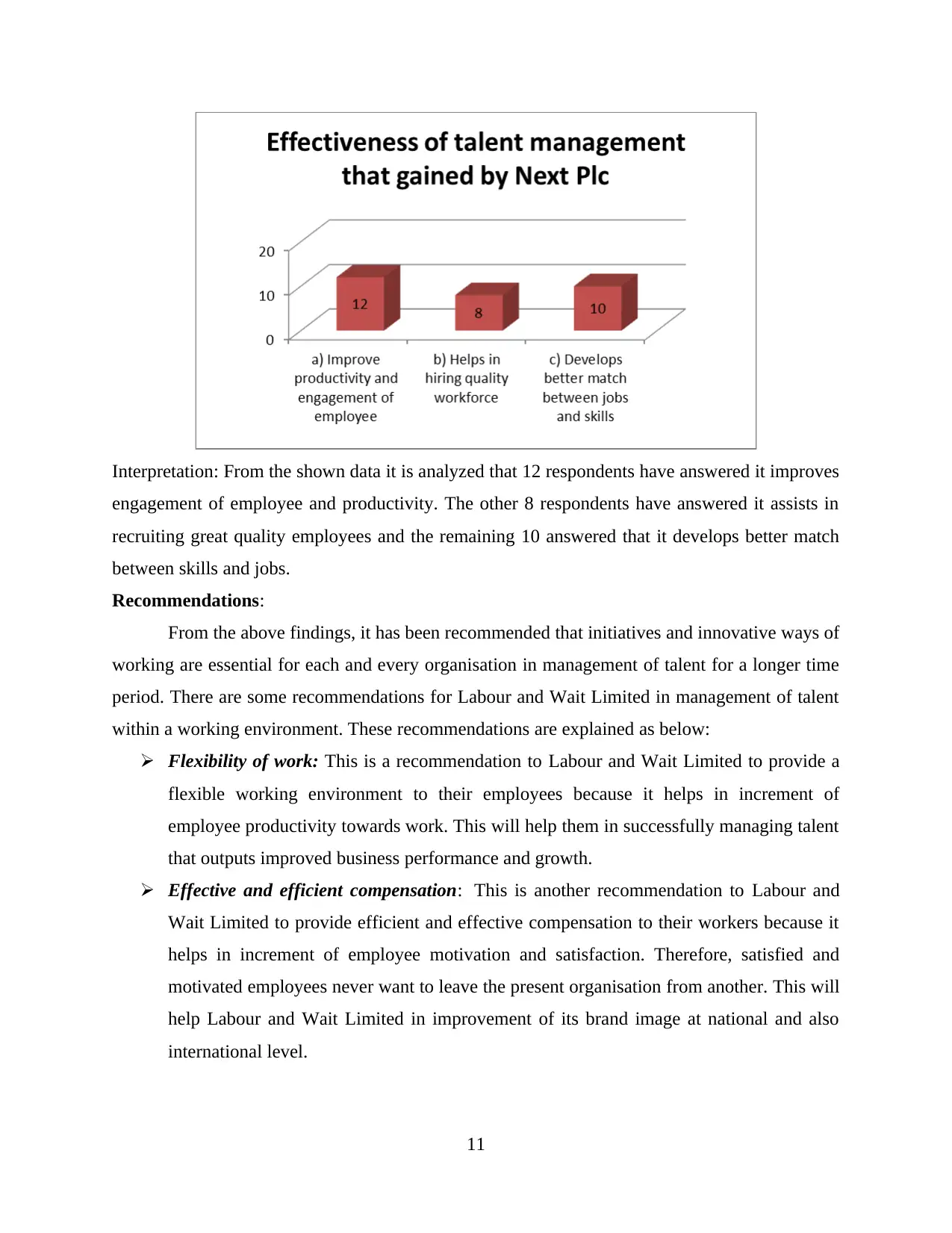
Interpretation: From the shown data it is analyzed that 12 respondents have answered it improves
engagement of employee and productivity. The other 8 respondents have answered it assists in
recruiting great quality employees and the remaining 10 answered that it develops better match
between skills and jobs.
Recommendations:
From the above findings, it has been recommended that initiatives and innovative ways of
working are essential for each and every organisation in management of talent for a longer time
period. There are some recommendations for Labour and Wait Limited in management of talent
within a working environment. These recommendations are explained as below:
Flexibility of work: This is a recommendation to Labour and Wait Limited to provide a
flexible working environment to their employees because it helps in increment of
employee productivity towards work. This will help them in successfully managing talent
that outputs improved business performance and growth.
Effective and efficient compensation: This is another recommendation to Labour and
Wait Limited to provide efficient and effective compensation to their workers because it
helps in increment of employee motivation and satisfaction. Therefore, satisfied and
motivated employees never want to leave the present organisation from another. This will
help Labour and Wait Limited in improvement of its brand image at national and also
international level.
11
engagement of employee and productivity. The other 8 respondents have answered it assists in
recruiting great quality employees and the remaining 10 answered that it develops better match
between skills and jobs.
Recommendations:
From the above findings, it has been recommended that initiatives and innovative ways of
working are essential for each and every organisation in management of talent for a longer time
period. There are some recommendations for Labour and Wait Limited in management of talent
within a working environment. These recommendations are explained as below:
Flexibility of work: This is a recommendation to Labour and Wait Limited to provide a
flexible working environment to their employees because it helps in increment of
employee productivity towards work. This will help them in successfully managing talent
that outputs improved business performance and growth.
Effective and efficient compensation: This is another recommendation to Labour and
Wait Limited to provide efficient and effective compensation to their workers because it
helps in increment of employee motivation and satisfaction. Therefore, satisfied and
motivated employees never want to leave the present organisation from another. This will
help Labour and Wait Limited in improvement of its brand image at national and also
international level.
11
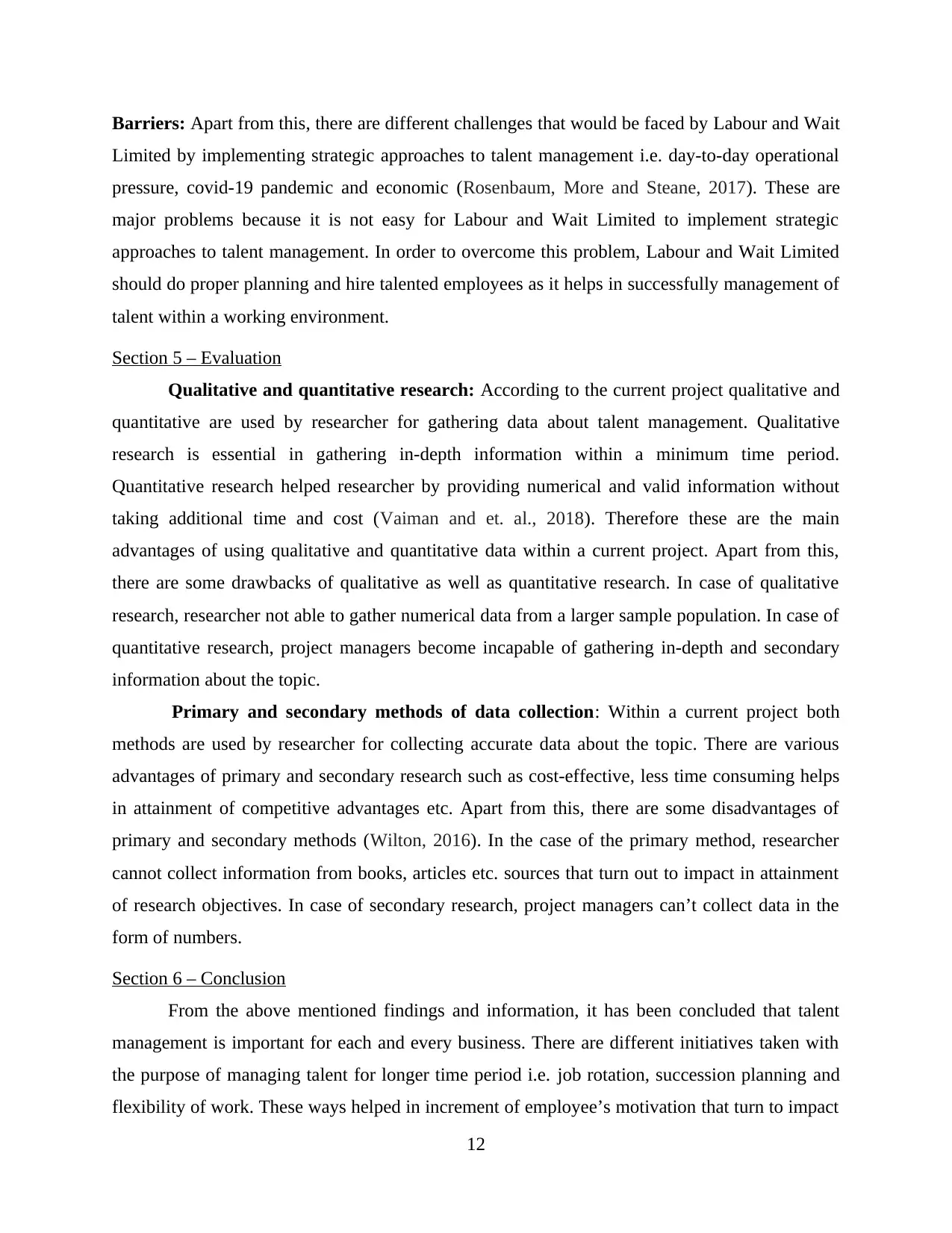
Barriers: Apart from this, there are different challenges that would be faced by Labour and Wait
Limited by implementing strategic approaches to talent management i.e. day-to-day operational
pressure, covid-19 pandemic and economic (Rosenbaum, More and Steane, 2017). These are
major problems because it is not easy for Labour and Wait Limited to implement strategic
approaches to talent management. In order to overcome this problem, Labour and Wait Limited
should do proper planning and hire talented employees as it helps in successfully management of
talent within a working environment.
Section 5 – Evaluation
Qualitative and quantitative research: According to the current project qualitative and
quantitative are used by researcher for gathering data about talent management. Qualitative
research is essential in gathering in-depth information within a minimum time period.
Quantitative research helped researcher by providing numerical and valid information without
taking additional time and cost (Vaiman and et. al., 2018). Therefore these are the main
advantages of using qualitative and quantitative data within a current project. Apart from this,
there are some drawbacks of qualitative as well as quantitative research. In case of qualitative
research, researcher not able to gather numerical data from a larger sample population. In case of
quantitative research, project managers become incapable of gathering in-depth and secondary
information about the topic.
Primary and secondary methods of data collection: Within a current project both
methods are used by researcher for collecting accurate data about the topic. There are various
advantages of primary and secondary research such as cost-effective, less time consuming helps
in attainment of competitive advantages etc. Apart from this, there are some disadvantages of
primary and secondary methods (Wilton, 2016). In the case of the primary method, researcher
cannot collect information from books, articles etc. sources that turn out to impact in attainment
of research objectives. In case of secondary research, project managers can’t collect data in the
form of numbers.
Section 6 – Conclusion
From the above mentioned findings and information, it has been concluded that talent
management is important for each and every business. There are different initiatives taken with
the purpose of managing talent for longer time period i.e. job rotation, succession planning and
flexibility of work. These ways helped in increment of employee’s motivation that turn to impact
12
Limited by implementing strategic approaches to talent management i.e. day-to-day operational
pressure, covid-19 pandemic and economic (Rosenbaum, More and Steane, 2017). These are
major problems because it is not easy for Labour and Wait Limited to implement strategic
approaches to talent management. In order to overcome this problem, Labour and Wait Limited
should do proper planning and hire talented employees as it helps in successfully management of
talent within a working environment.
Section 5 – Evaluation
Qualitative and quantitative research: According to the current project qualitative and
quantitative are used by researcher for gathering data about talent management. Qualitative
research is essential in gathering in-depth information within a minimum time period.
Quantitative research helped researcher by providing numerical and valid information without
taking additional time and cost (Vaiman and et. al., 2018). Therefore these are the main
advantages of using qualitative and quantitative data within a current project. Apart from this,
there are some drawbacks of qualitative as well as quantitative research. In case of qualitative
research, researcher not able to gather numerical data from a larger sample population. In case of
quantitative research, project managers become incapable of gathering in-depth and secondary
information about the topic.
Primary and secondary methods of data collection: Within a current project both
methods are used by researcher for collecting accurate data about the topic. There are various
advantages of primary and secondary research such as cost-effective, less time consuming helps
in attainment of competitive advantages etc. Apart from this, there are some disadvantages of
primary and secondary methods (Wilton, 2016). In the case of the primary method, researcher
cannot collect information from books, articles etc. sources that turn out to impact in attainment
of research objectives. In case of secondary research, project managers can’t collect data in the
form of numbers.
Section 6 – Conclusion
From the above mentioned findings and information, it has been concluded that talent
management is important for each and every business. There are different initiatives taken with
the purpose of managing talent for longer time period i.e. job rotation, succession planning and
flexibility of work. These ways helped in increment of employee’s motivation that turn to impact
12
⊘ This is a preview!⊘
Do you want full access?
Subscribe today to unlock all pages.

Trusted by 1+ million students worldwide
1 out of 21
Related Documents
Your All-in-One AI-Powered Toolkit for Academic Success.
+13062052269
info@desklib.com
Available 24*7 on WhatsApp / Email
![[object Object]](/_next/static/media/star-bottom.7253800d.svg)
Unlock your academic potential
Copyright © 2020–2025 A2Z Services. All Rights Reserved. Developed and managed by ZUCOL.





